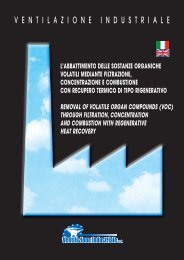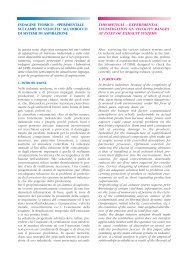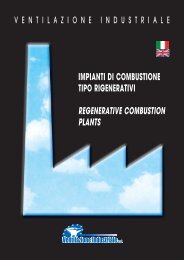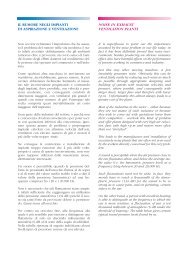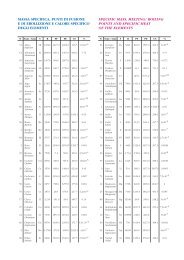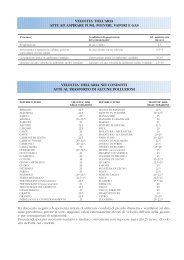Ricambio dell'aria negli ambienti di lavoro - Ventilazione Industriale
Ricambio dell'aria negli ambienti di lavoro - Ventilazione Industriale
Ricambio dell'aria negli ambienti di lavoro - Ventilazione Industriale
You also want an ePaper? Increase the reach of your titles
YUMPU automatically turns print PDFs into web optimized ePapers that Google loves.
percentuale delle sostanze inquinanti al <strong>di</strong> sotto dei<br />
valori massimi ammessi, ed atto inoltre a contenere<br />
entro limiti <strong>di</strong> benessere fisiologico l'aumento <strong>di</strong><br />
umi<strong>di</strong>tà e temperatura causato dalle persone e dai<br />
mezzi <strong>di</strong> <strong>lavoro</strong>.<br />
Essendo in generale insufficiente l'aereazione naturale,<br />
il rinnovamento <strong>dell'aria</strong> avviene in gran parte<br />
artificial-mente.<br />
Come regola generale vale quella <strong>di</strong> immettere aria<br />
pulita dall'esterno, in modo da provocare una lieve<br />
sovrap-pressione nell'ambiente <strong>di</strong> <strong>lavoro</strong> e <strong>di</strong><br />
impe<strong>di</strong>re la penetrazione delle polveri.<br />
Qualunque sia il mezzo adottato per il ricambio<br />
dell' aria si deve evitare che le correnti colpiscano<br />
<strong>di</strong>rettamente i lavoratori addetti a posti fissi <strong>di</strong> <strong>lavoro</strong>.<br />
Le correnti d'aria provocano infatti sui soggetti<br />
colpiti un danno <strong>di</strong>pen-dente dal raffreddamento<br />
che è <strong>di</strong>rettamente proporzionale all'umi<strong>di</strong>tà della<br />
corrente ed inversamente proporzio-nale alla sua<br />
temperatura.<br />
E consigliabile perciò che la velocità <strong>dell'aria</strong> <strong>di</strong>retta<br />
verso le persone non superi 0,50 m/sec., tenendo<br />
presente che soggetti particolarmente sensibili<br />
hanno sensazioni <strong>di</strong> fasti<strong>di</strong>o anche per valori <strong>di</strong><br />
spostamento d'aria appena percettibili.<br />
Occorre inoltre ricordare che è sempre preferibile<br />
un ambiente leggermente fresco con aria frequentemente<br />
rinno-vata ad uno più caldo con aria ferma<br />
e viziata.<br />
Nell'assenza <strong>di</strong> precise <strong>di</strong>sposizioni <strong>di</strong> legge in<br />
materia, alla pagina seguente riportiamo una tabella<br />
in<strong>di</strong>cativa dei ricambi d'aria consigliati per alcuni<br />
tipi <strong>di</strong> locali.<br />
From what has been stated up till now it is clear<br />
that an exhaust system is required capable of<br />
reducing the percentage of contaminating substances<br />
to under the max. allowable concentrations;<br />
such system should also be able to keep the<br />
increase in humi<strong>di</strong>ty and temperature caused by<br />
persons and work tools to within the physiological<br />
comfort limits.<br />
As natural ventilation is normally insufficient, the<br />
air is renewed mainly by artificial means.<br />
We can take as general rule that of introducing<br />
clean air from the outside in order to produce a<br />
slight overpressure in the work environment and to<br />
prevent the ingress of dusts.<br />
Whatever means is adopted for the air change,<br />
measures must be taken to avoid draughts from<br />
<strong>di</strong>rectly hitting the workers in the fixed workplaces.<br />
In fact the air currents cause damage to the in<strong>di</strong>vidual<br />
affected, depen<strong>di</strong>ng on the cooling which is<br />
<strong>di</strong>rectly proportional to the moisture in the air current<br />
and inversely proportio-nal to its temperature.<br />
Hence it is advisable for the air velocity <strong>di</strong>rected<br />
towards persons not to exceed 0.50 m/sec., bearing<br />
in mind that especially sensitive persons feel nuisance<br />
effects also for barely perceptible air movements.<br />
It should also be remembered that a slightly cool<br />
environment with air frequently renewed is always<br />
preferable to a warmer one with still and stale air.<br />
In the absence of exact legislative provisions on the<br />
subject, a table is given on the following page in<strong>di</strong>cating<br />
the recommended air changes for certain<br />
types of room.




